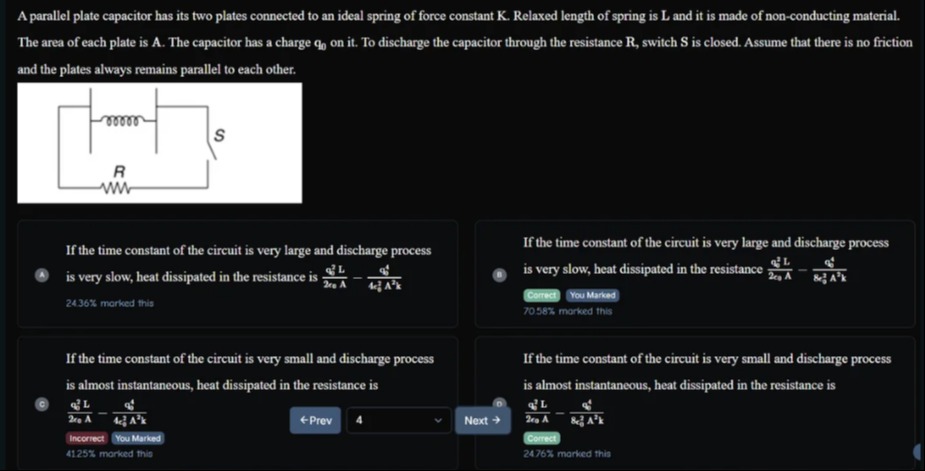Question
Question: A parallel plate capacitor has its two plates connected to an ideal spring of force constant K. Rela...
A parallel plate capacitor has its two plates connected to an ideal spring of force constant K. Relaxed length of spring is L and it is made of non-conducting material. The area of each plate is A. The capacitor has a charge q0 on it. To discharge the capacitor through the resistance R, switch S is closed. Assume that there is no friction and the plates always remains parallel to each other.
If the time constant of the circuit is very large and discharge process is very slow, heat dissipated in the resistance is

2ϵ0Aq02L−4ϵ02A2Kq04
2ϵ0Aq02L−8ϵ02A2Kq04
2ϵ0Aq02L−4ϵ02A2Kq04
2ϵ0Aq02L−8ϵ02A2Kq04
2ϵ0Aq02L−8ϵ02A2Kq04
Solution
The system consists of a parallel plate capacitor and a spring. The capacitor has an initial charge q0. The plates are connected to a spring with relaxed length L and force constant K. The electrostatic force between the plates is attractive, Fe=2ϵ0Aq2. We assume the spring is connected such that it provides a restoring force towards the relaxed length L. Based on the options, we infer that the spring force is K(L−x) inwards, where x is the distance between the plates. The initial state is mechanical equilibrium with charge q0, so 2ϵ0Aq02=K(L−x0), which gives x0=L−2ϵ0AKq02. This requires L>2ϵ0AKq02.
The initial total energy of the system is the sum of the initial electrical energy and the initial spring potential energy: Einitial=21C0q02+21K(L−x0)2=21q02ϵ0Ax0+21K(L−x0)2. Substituting x0 and L−x0, we get Einitial=2ϵ0Aq02L−4ϵ02A2Kq04+8ϵ02A2Kq04=2ϵ0Aq02L−8ϵ02A2Kq04.
When the capacitor is fully discharged, q=0, and the plates reach the final equilibrium position where the spring force is zero, i.e., xf=L. The final total energy is Efinal=0.
In the case of very slow discharge, the system remains in mechanical equilibrium throughout the process. By conservation of energy, the heat dissipated in the resistor is equal to the decrease in the total energy of the system: H=Einitial−Efinal=2ϵ0Aq02L−8ϵ02A2Kq04.
